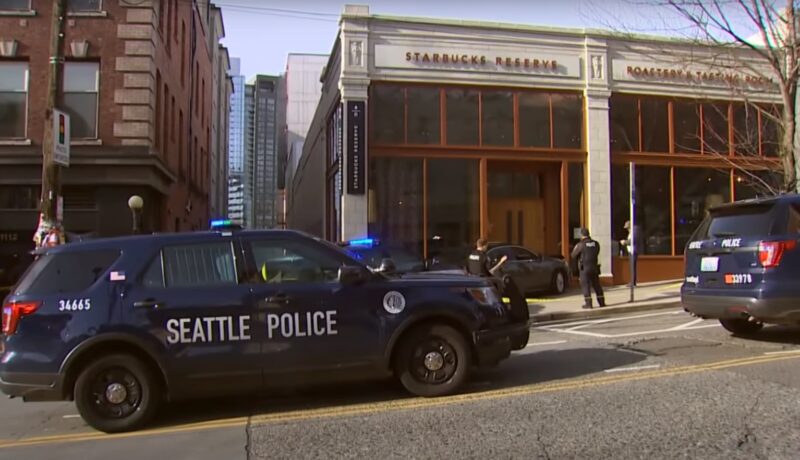Seattle stands as the largest city in the Pacific Northwest and ranks among the fastest-growing major cities in the country.
I find it fascinating that it’s about 100 miles from the Canadian border, making it the northernmost major city in the U.S. Not to mention, its port ranks as the fourth-largest in North America.
The city boasts landmarks like the iconic Space Needle and hosts major companies such as Boeing, Microsoft, and Amazon.
When it comes to safety, I believe Seattle is a safe place to live. Like any major city, it experiences a higher crime rate, but that’s a common trait among large urban areas.
Certain parts of the city do have higher crime rates and are best avoided.
[su_note note_color=”#ededed”]
Key Takeaways
- Seattle has a lower violent crime rate but a much higher property crime rate than the national average.
- Over the last three months of 2024, Seattle reported 429 violent crimes and 3,053 property crimes.
- Seattle is tackling crime through community engagement, proactive policing, and addressing root causes like drug addiction and homelessness.
- From 2021 to 2022, violent and property crimes in Seattle increased by 4%, with notable rises in homicides and motor vehicle thefts.
- The Seattle Police Department divides the city into five precincts for targeted, localized policing efforts.[/su_note]
Crime Stats

Seattle, with a population of over 700,000, is the largest city in Washington State and the Pacific Northwest region. The city’s rate is a topic of concern for residents, policymakers, and law enforcement agencies. According to Seattle.gov[1], the total number of crimes in the past three months is 3,482.
Seattle’s unique location and diverse, tech-driven economy pose challenges for its police force. Despite these challenges, the city has seen progress in reducing crime. However, more efforts are needed.
The Seattle Police Department and other agencies are refining their strategies to address crime more effectively. They collaborate with community organizations and residents to enhance trust and safety.
This shows us that urban violence is complex, just like in other cities dealing with their own mess. We gotta mix it up with different strategies to actually cut down on all the incidents.
Violent And Property Crimes Statistics

| Crime Type | Seattle 2024 |
|---|---|
| Violent Crime | 429 |
| Property Crime | 3,053 |
According to data from NeighborhoodScout[2], the chance of becoming a victim of a violent crime in Seattle is 1 in 122, compared to 1 in 266 in Washington state overall. This indicates that while the violent rate is higher in Seattle than in the state as a whole, the risk is still relatively low compared to other major cities.
In Seattle, violent crimes, despite their prominence in the media, make up only a small portion of all crimes.
The city’s police are dedicated to lowering these incidents and safeguarding everyone’s safety. Their approach includes proactive patrols, engaging with the community, and analyzing crime data to both prevent and address violence.
Despite these efforts, certain areas of the city continue to experience higher rates of violent crime. These areas often face a range of complex social and economic challenges, including poverty, unemployment, and lack of access to quality education and healthcare.
The likelihood of experiencing property crime is 1 in 17, whereas it’s 1 in 30 for Washington as per same source.
These crimes are fueled by various issues such as drug addiction[3], poverty, and unstable housing situations[4],. They significantly affect residents’ quality of life and can lead to increased feelings of insecurity and fear.
Comparing the Past Years
| Offense Category | Offense | 2022 | 2021 | 2020 | AMT CHANGE (2022-2021) | % CHANGE (2022-2021) |
|---|---|---|---|---|---|---|
| Violent | ||||||
| HOMICIDE | 52 | 40 | 53 | 10 | 24% | |
| RAPE | 281 | 253 | 270 | 11 | 4% | |
| ROBBERY | 1,760 | 1,752 | 1,487 | 5 | 0% | |
| AGGRAVATED ASSAULT | 3,498 | 3,295 | 2,656 | 172 | 5% | |
| Violent Total | 5,591 | 5,340 | 4,466 | 198 | 4% | |
| Property | ||||||
| ARSON | 181 | 224 | 171 | -43 | -19% | |
| BURGLARY | 8,657 | 9,787 | 10,443 | -1,169 | -12% | |
| LARCENY-THEFT | 28,228 | 26,733 | 23,188 | 1,252 | 5% | |
| MOTOR VEHICLE THEFT | 6,920 | 5,305 | 4,912 | 1,596 | 30% | |
| Property Total | 43,986 | 42,049 | 38,714 | 1,636 | 4% | |
| Grand Total | 49,577 | 47,389 | 43,180 | 1,834 | 4% |
Source: Seattle.gov
6 Riskiest Places in Seattle
1. Sand Point[5] really stands out for its alarmingly high violent crime rate of 3,467 incidents per 100k people. That’s over three times the Seattle average, which is especially worrying given its small population of just 788 people. This statistic makes it the most concerning area in terms of violent crime.
2.Following closely is First Hill[5.1], where the vibrant city life is overshadowed by a violent crime rate of 2,261 incidents per 100k people. This rate is 170% higher than Seattle’s overall average, which is significant for an area housing 13,005 residents.
3. South Lake Union[5.2], known for its tech-driven revitalization, has not been spared, showing a violent crime rate of 1,963 incidents per 100k people, 134% more than the Seattle average, amidst its 7,155 residents.
4. Atlantic[5.3], with a community of 5,555, faces a violent crime rate of 1,946 incidents per 100k people, or 132% above Seattle’s average, highlighting significant safety concerns.
5. Northgate[5.4], though slightly better, still reports a violent crime rate of 1,897 incidents per 100k people among its 4,414 inhabitants, 126% more than the city’s norm.
6. Haller Lake[5.5] presents a somewhat lower but still concerning figure, with a violent crime rate of 1,429 incidents per 100k people, 71% higher than Seattle’s average, in its population of 9,105.
METHODOLOGY
For our analysis of Seattle’s crime rates, we use the annual crime data provided by the FBI and the city’s police department. This data comes in two main parts: an initial summary targeting the largest cities in the U.S. and a year-end report.
Our investigation focuses on two main indicators:
- Violent Crime Rates Per Capita
- Property Crime Rates Per Capita
Our detailed study primarily looks at Seattle but also includes data from other cities in Washington for a broader statewide comparison.
FAQ
[su_accordion]
[su_spoiler title=”How does the crime rate in Seattle compare to other cities?” style=”fancy”] Seattle’s violent crime rate is relatively lower than other cities of its size, but it has a much higher property crime rate than the national average.[/su_spoiler]
[su_spoiler title=”What are my chances of being a victim of violent crime in Seattle?” style=”fancy”] In Seattle, your chances of being a victim of violent crime are 1 in 125. This contrasts with a 1 in 298 chance across the state of Washington. [/su_spoiler]
[su_spoiler title=”How likely am I to experience property crime in Seattle?” style=”fancy”] The likelihood of experiencing property crime in Seattle is 1 in 18, compared to a 1 in 32 chance statewide in Washington. [/su_spoiler]
[su_spoiler title=”What causes Seattle’s crime rate to be what it is?” style=”fancy”] Factors such as high population density, varying socioeconomic conditions, drug use, and the practices of local law enforcement contribute to the city’s crime rate. [/su_spoiler]
[su_spoiler title=”How is law enforcement organized in Seattle?” style=”fancy”] Seattle Police Department divides the city into five precincts or geographical areas. This division helps in applying localized policing strategies. [/su_spoiler]
[su_spoiler title=”Where can I find detailed information about crime in Seattle?” style=”fancy”] The Seattle Police Department’s website offers a dashboard with detailed crime data. Local news sources like the Seattle Times and KING 5 also provide information. [/su_spoiler]
[su_spoiler title=”What types of crime are most common in Seattle?” style=”fancy”] Property crimes, including burglary, theft, and motor vehicle theft, are the most reported crimes in Seattle, far outnumbering violent crimes like murder, rape, robbery, and aggravated assault. [/su_spoiler]
[su_spoiler title=”Has Seattle’s crime rate changed over time?” style=”fancy”] Yes, Seattle’s crime rate has seen changes over the years, with a decrease in violent crime and an increase in property crime. Factors like law enforcement strategies, economic conditions, and population changes influence these trends. [/su_spoiler]
[/su_accordion]
Final Thoughts
The recent data shows Seattle has a higher property crime rate than the national average, even though its violent crime rate is relatively lower. This means while the city is generally safe, property crimes like theft, burglary, and vehicle theft are common.
In the last few months, we’ve seen a lot more property crimes than violent crimes. Addressing property crimes means tackling underlying issues such as drug addiction and homelessness, which need comprehensive solutions.
References:
1. Seattle.gov: https://www.seattle.gov/police/information-and-data/data/crime-dashboard
2. NeighborhoodScout: https://www.neighborhoodscout.com/wa/seattle/crime
3. Substance Abuse and Mental Health Services Administration: https://www.samhsa.gov/data/sites/default/files/NSDUHMetroBriefReports/NSDUHMetroBriefReports/NSDUH-Metro-Seattle.pdf
5. AreaVibes: https://www.areavibes.com/seattle-wa/sand+point/crime/
- 5.1: https://www.areavibes.com/seattle-wa/first+hill/crime/
- 5.2: https://www.areavibes.com/seattle-wa/south+lake+union/crime/
- 5.3: https://www.areavibes.com/seattle-wa/atlantic/crime/
- 5.4: https://www.areavibes.com/seattle-wa/northgate/crime/
- 5.5: https://www.areavibes.com/seattle-wa/haller+lake/crime/
Related Posts:
- Denver Crime Rate 2024: Dark Secrets Behind Mile-High City
- Crime Rate in Las Vegas 2024 - The Fruits of Sin City
- Only City Where Crime Rate Increases in 2024 - LA
- 10 Most Dangerous US States 2024 - Risk Zones Revealed
- Miami Crime Rate 2024 - The Other Side of the Sun
- Boston Crime Rate For 2024: A Year of Challenges and…







